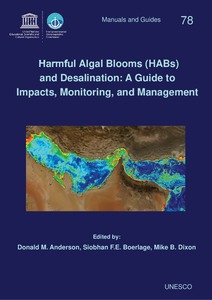| dc.contributor.author | Dixon, Mike B. | |
| dc.contributor.author | Boerlage, Siobhan F.E. | |
| dc.contributor.author | Churman, Holly | |
| dc.contributor.author | Henthorne, Lisa | |
| dc.contributor.author | Anderson, Donald M. | |
| dc.date.accessioned | 2019-01-19T00:25:41Z | |
| dc.date.available | 2019-01-19T00:25:41Z | |
| dc.date.issued | 2017 | |
| dc.identifier.citation | Dixon, M. B.; Boerlage, S.F.E.; Churman, H.; Henthorne, L. and Anderson, D. M.(2017) Removal of algal toxins and taste and odor compounds during desalination. In: Harmful Algal Blooms (HABs) and Desalination: A Guide to Impacts, Monitoring and Management. (eds. Anderson D. M.; Boerlage, S. F. E. and Dixon, M.B.), Paris, France, Intergovernmental Oceanographic Commission of UNESCO, pp.315-332. (IOC Manuals and Guides No. 78). DOI: http://dx.doi.org/10.25607/OBP-315 | en_US |
| dc.identifier.uri | http://hdl.handle.net/11329/758 | |
| dc.identifier.uri | http://dx.doi.org/10.25607/OBP-315 | |
| dc.description.abstract | A major challenge in desalination is the removal of harmful algal bloom (HAB) toxins and
taste and odor compounds (hereafter referred to as algal metabolites) using common
treatment techniques. Removal of other compounds such as polysaccharides, proteins or
transparent exopolymer particles (TEP) are discussed in Chapter 2. Taste and odor
compounds are materials produced during a HAB that are not detrimental to human health,
but cause customer dissatisfaction and often a misconception that the drinking water is not
suitable for consumption. Toxins are detrimental to human health and are discussed in
Chapter 2. Here the objective is to assess each process unit in a common desalination
treatment train, both for SWRO and thermal desalination, and address how each is best
optimized to act as a barrier to these specific algal metabolites. Where treatment techniques
in seawater applications exist, these have been referenced and used as examples. As little
documentation exists on removal of algal metabolites from seawater blooms, fresh water
algal species are referred to whenever needed. This information is relevant in understanding
the removal mechanisms that are possible. For clarity, these are denoted for each example.
Algal metabolites can be either intracellular or extracellular. Many algal species have high
percentages of intracellular metabolites, such as Microcystis (freshwater) in which the toxin
microcystin can be up to 98% intracellular (Chow et al. 1997). Lefebvre et al. (2008) showed
an approximate 81% intracellular saxitoxin (STX)-equivalent concentration for an
Alexandrium (seawater) bloom, although further data are needed to confirm this observation.
STX-eq (or STX-equivalents) is a measure of total toxicity due to all saxitoxin analogues in a
particular solution. In contrast, Smith et al. (2012) report that 60% of the okadaic acid
produced by Dinophysis cultures was extracellular, while Kudela (pers. comm.) reported total
and extracellular concentrations of 100 and 50 μg/L domoic acid respectively during a massive bloom of Pseudo-nitzschia along the US west coast in 2014. Extracellular metabolites are inefficiently removed by pretreatment processes, and this is discussed below
in more detail.
The nutritional status of HAB cells will affect the percentage of extracellular metabolites in a
bloom. At the outset of a bloom, HAB cells will be more robust than toward the end of the
bloom period when stresses from nutrient limitation, grazing, or other factors can lead to the
leakage of metabolites into the seawater. Smith et al. (2012) noted that, in general, the
concentration of extracellular toxin in a lab culture of Dinophysis acuminata (seawater)
significantly increased upon culture aging and decline; cells did not appear to be actively or
passively releasing toxin during the stationary phase (see Chapter 1, Figure 1.3), but rather
extracellular release was likely a result of cell death. | en_US |
| dc.language.iso | en | en_US |
| dc.publisher | Intergovernmental Oceanographic Commission of UNESCO | en_US |
| dc.relation.ispartofseries | Intergovernmental Oceanographic Commission Manuals and Guides;78 | |
| dc.rights | No Creative Commons license | |
| dc.title | Removal of algal toxins and taste and odor compounds during desalination. | en_US |
| dc.type | Report Section | en_US |
| dc.description.status | Published | en_US |
| dc.description.refereed | Refereed | en_US |
| dc.publisher.place | Paris, France | en_US |
| dc.format.pagerange | pp.315-332 | en_US |
| dc.subject.parameterDiscipline | Parameter Discipline::Biological oceanography | en_US |
| dc.description.currentstatus | Current | en_US |
| dc.contributor.editorparent | Anderson, D.M. | |
| dc.contributor.editorparent | Boerlage, S.F.E. | |
| dc.contributor.editorparent | Dixon, M.B. | |
| dc.title.parent | Harmful Algal Blooms (HABs) and Desalination: a Guide to Impacts, Monitoring and Management. | en_US |
| dc.description.sdg | 14.1 | en_US |
| dc.description.bptype | Manual | en_US |
| obps.contact.contactemail | danderson@whoi.edu | |
| obps.resourceurl.publisher | http://hab.ioc-unesco.org/index.php?option=com_oe&task=viewDocumentRecord&docID=22885 | en_US |
 Repository of community practices in Ocean Research, Applications and Data/Information Management
Repository of community practices in Ocean Research, Applications and Data/Information Management
